
The Serious Freshening
Go to <Last, Summary, Next>Interior—Speedometer
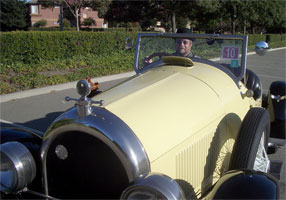 Lynn in Bugsby, September 5, 2005 |
Completed: 2008-08-24 — Started: 2006-07-01
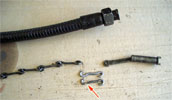 |
 |
 |
 |
|
| A Sep. 2005 repair of the speedometer cable is a disaster. | ||||
Work Completed:
The existing speedometer is not operating because the speedometer cable is broken. It comes as a surprise to Lynn that Bugsby uses a chain-link cable to connect the speedometer to the transmission. It's the first time he's run into this on a car.
In 2005 Lynn fabricates a replacement for a broken link. Within seconds of taking the car for a test spin, the new link snags and wraps the outer sheath into a tangled mess that needs to be cut off with a hack saw. Well that didn't work out as well as Lynn had hoped!
Lynn has read that many people replace the chain with a modern speedometer cable, installing it within the old sheath. As Lynn has destroyed the old sheath, he'll need to replace that, too.
| |
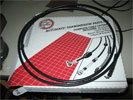 |
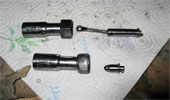 |
 |
| Salvaging the old sheath ends and adapter tips, a modern speedometer cable is installed inside a new 5/8" conduit. | ||
| |
Using a 5/8" German-silver conduit he orders from Restoration Supply Company and a modern speedometer cable with sheath that he buys at Monument Car Parts, Lynn creates a new speedometer cable. He doesn't believe the details of the new cable are important if it is long enough. Thanks to the help of the folks at Monument, Lynn uses a cable for a 1988-90 Dodge van or pickup. At 92" it is way longer than the 66" length he needs for this application.
For the longest time Lynn thinks about how he is going to fasten the sheath of the new cable to the old sheath. The big break came when Lynn realizes that he doesn't need to do that. As the adapters at the speedometer and transmission ends of the cable are captured by the old sheath ends, the new sheath doesn't have to be fixed or fastened, making the installation dirt simple. Lynn will retain the small sheath of the new cable to take up much of the volume inside the larger outer 5/8" sheath to try and reduce slop and oscillation, but won't worry about trying to keep it fixed.
Lynn pulls out the inner cable from the new sheath, cuts one end of the new cable so that it fits comfortably inside the length of the outer 5/8" conduit.
It gets even simpler when Lynn realizes that the new 5/8" outer conduit can be stretched or collapsed by many inches. As a result, careful measurement of the exact length of the new inner cable isn't very critical. The outer conduit could be expanded or contracted to accommodate the resulting cut.
Lynn cleans up and reuses the old speedometer and transmission adapter tips and the outer connectors from the old sheath. To connect the transmission and speedometer adapters to the ends of the new inner cable, he uses a couple of the old chain links. Breaking off one end and using a small brass tube as a coupler, he first crimps then solders the chain links to the end of the new cable. Then it is a simple matter to connect the speedometer and transmission adapters tips to the cable.
| |
 |
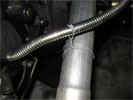 |
|
| The new cable is installed in Bugsby. A wire bracket (right) keeps the cable off the exhaust pipe. | ||
| |
Lynn takes some extra time to buff the German-silver conduit to a bright shine, wondering if he should paint it with a clear coat. As he's seen other clear coats that look good for a while, but eventually look terrible, he decides not to paint the cable.
(Maybe you already know what German silver is made of. No, it's not silver. Also known as nickel silver, new silver, paktong and alpacca, it is an alloy of copper with nickel and often but not always zinc, according to Wikipedia.)
The new cable is easily installed in Bugsby. Lynn creates a simple wire bracket to keep the cable from lying on the exhaust pipe and potentially melting the plastic and nylon components of the new inner cable and sheath.
Work Remaining:
None.
Contact
 with your comments or questions
with your comments or questionsCopyright © 2018 Lynn Kissel
Last updated: May 24, 2009